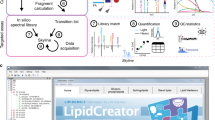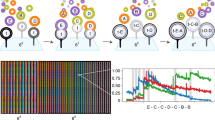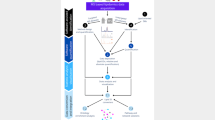Abstract
Lipids have a role in virtually all biological processes, acting as structural elements, scaffolds and signaling molecules, but they are still largely under-represented in known biological networks. Here we describe a liposome microarray–based assay (LiMA), a method that measures protein recruitment to membranes in a quantitative, automated, multiplexed and high-throughput manner.
This is a preview of subscription content, access via your institution
Access options
Subscribe to this journal
Receive 12 print issues and online access
$259.00 per year
only $21.58 per issue
Buy this article
- Purchase on Springer Link
- Instant access to full article PDF
Prices may be subject to local taxes which are calculated during checkout



Similar content being viewed by others
References
Di Paolo, G. & De Camilli, P. Nature 443, 651–657 (2006).
Gallego, O. et al. Mol. Syst. Biol. 6, 430–444 (2010).
Leonard, T.A., Różycki, B., Saidi, L.F., Hummer, G. & Hurley, J.H. Cell 144, 55–66 (2011).
Narayan, K. & Lemmon, M.A. Methods 39, 122–133 (2006).
Wu, H.J. et al. Nat. Methods 9, 1189–1191 (2012).
Jung, H., Robison, A.D. & Cremer, P.S. J. Struct. Biol. 168, 90–94 (2009).
Majd, S. & Mayer, M. Angew. Chem. Int. Edn Engl. 44, 6697–6700 (2005).
Estes, D.J., Lopez, S.R., Fuller, A.O. & Mayer, M. Biophys. J. 91, 233–243 (2006).
Walde, P., Cosentino, K., Engel, H. & Stano, P. ChemBioChem 11, 848–865 (2010).
Jesorka, A. & Orwar, O. Annu. Rev. Anal. Chem. (Palo Alto Calif.) 1, 801–832 (2008).
Horger, K.S., Estes, D.J., Capone, R. & Mayer, M. J. Am. Chem. Soc. 131, 1810–1819 (2009).
Duffy, D.C., McDonald, J.C., Schueller, O.J. & Whitesides, G.M. Anal. Chem. 70, 4974–4984 (1998).
Neumann, B. et al. Nat. Methods 3, 385–390 (2006).
Carpenter, A.E. et al. Genome Biol. 7, R100 (2006).
Lemmon, M.A. Nat. Rev. Mol. Cell Biol. 9, 99–111 (2008).
Rosse, C. et al. Nat. Rev. Mol. Cell Biol. 11, 103–112 (2010).
Findlay, G.M. et al. Cell 152, 1008–1020 (2013).
Yadav, K.K. & Bar-Sagi, D. Proc. Natl. Acad. Sci. USA 107, 3436–3440 (2010).
Huh, W.K. et al. Nature 425, 686–691 (2003).
Hutchins, J.R. et al. Science 328, 593–599 (2010).
Pédelacq, J.D., Cabantous, S., Tran, T., Terwilliger, T.C. & Waldo, G.S. Nat. Biotechnol. 24, 79–88 (2006).
Bartolo, D., Degré, G., Nghe, P. & Studer, V. Lab Chip 8, 274–279 (2008).
Qin, D., Xia, Y. & Whitesides, G.M. Nat. Protoc. 5, 491–502 (2010).
Wu, H., Huang, B. & Zare, R.N. Lab Chip 5, 1393–1398 (2005).
Acknowledgements
We dedicate this paper to T.P. We are grateful to C. Merten, M. Kaksonen, A. Galih, K. Kugler, C. Besir, M. Hsiung, M. Skruzny and the Protein Expression and Purification Core Facility for expert help and the sharing of reagents. We thank M. Mall (European Molecular Biology Laboratory) for the PKCγ and PKCδ (in the pEGFP-N3 vector). We also thank J.E.'s and other members of A.-C.G.'s groups for continuous discussions and support. This work was partially funded by the German Federal Ministry of Education and Research (BMBF; 01GS0865) in the framework of the IG-Cellular System genomics to A.-C.G. K.M. was supported by the Danish Natural Science Research Council (09-064986/FNU). A.-E.S. is supported by the European Molecular Biology Laboratory and the EU Marie Curie Actions Interdisciplinary Postdoctoral Cofunded Programme.
Author information
Authors and Affiliations
Contributions
A.-E.S., I.V., J.E., V.v.N., P.B., T.P. and A.-C.G. designed the research, discussed the results and/or advised on the analyses; A.-E.S., I.V., S.C. and S.D. conducted the experiments and performed the analyses; G.M.F., K.M. and C.T. provided key technical expertise with instrumentation, protocols and reagents; and A.-E.S., I.V. and A.-C.G. wrote the manuscript with support from all the authors.
Corresponding author
Ethics declarations
Competing interests
A.-E.S., I.V., J.E. and A.-C.G. are named on the international patent application PCT/EP2013/065256, "Giant liposome array for high-throughput lipid-protein interaction screening," which is based on the results described in this study.
Supplementary information
Supplementary Text and Figures
Supplementary Figures 1–6, Supplementary Tables 1–3 and Supplementary Note (PDF 1596 kb)
Bright-field image showing liposome formation on a thin agarose layer (TAL)
At the initial time point (t = 0 s), a phosphate buffered saline (PBS, pH 7.4) is injected upon TAL inked with a lipid mixture composed of PC. Lipids self-assemble in liposomes in less than 3 minutes. (MOV 1082 kb)
Rights and permissions
About this article
Cite this article
Saliba, AE., Vonkova, I., Ceschia, S. et al. A quantitative liposome microarray to systematically characterize protein-lipid interactions. Nat Methods 11, 47–50 (2014). https://doi.org/10.1038/nmeth.2734
Received:
Accepted:
Published:
Issue Date:
DOI: https://doi.org/10.1038/nmeth.2734
This article is cited by
-
Model architectures for bacterial membranes
Biophysical Reviews (2022)
-
Lysosomal integral membrane protein-2 (LIMP-2/SCARB2) is involved in lysosomal cholesterol export
Nature Communications (2019)
-
Annexin A7 is required for ESCRT III-mediated plasma membrane repair
Scientific Reports (2019)
-
Chemical biology: fats as research subjects
Nature Methods (2018)
-
Annexins induce curvature on free-edge membranes displaying distinct morphologies
Scientific Reports (2018)



